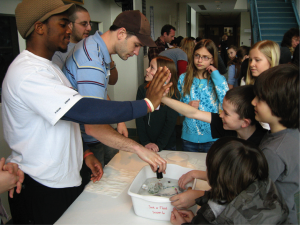Main Content
Are you interested in adding more STEM activities to your animal science club? If so, you may be wondering what to look for in a quality STEM activity? We all know the power of the Internet to search and find anything. We all use Google searches or ask Siri or Alexa for help finding information. However sorting through the thousands of links we get back can be overwhelming. Figuring out what is and what isn’t a quality activity can be more complicated than we think.
Let’s start with defining what we mean by quality. In short, I encourage you to look for activities that help learners engage in the scientific practices (asking testable questions, experimenting, collecting data, analyzing information/data, etc.) or the engineering design process (define a problem, develop a solution, evaluate, iterate and optimize solution). Quality activities also encourage collaboration, and focus on real-world ideas or problems.

A quality activity has a measure of excellence. Activities that are high quality take advantage of our educational knowledge and theories about how people learn best.
In addition, there are lots of practical considerations when choosing an activity. Of course it must be safe to do and appropriate for the age group you are working with in the club. Beyond the basics there are some considerations you can take into account when selecting an activity. Here is a short checklist to consider:
Quality activities should:
- Drive curiosity: Will the activity surprise or intrigue your young people? Focus on a real-world problem or phenomena that has meaning to your club members.
- Offer a sense of accomplishment: Will this activity give youth confidence and a sense of competence? Introduce club members to expert knowledge and guide them toward their own sense of mastery and accomplishment. This is of course one of the essential elements in 4-H.
- Provide a challenge: Is there something for them to work toward in the activity? Do they have motivation to achieve the task outlined in the activity?
- Provide control in doing the activity: Try not to make the activity too “cookbook” or demonstration oriented. Choose hands-on activities that ask lots of questions and make the club members feel like they are experimenting or discovering something new. Young people should communicate to share ideas. Encourage them to control their own ideas and design their own investigations.
- Encourage play: Allow the club members to play and have fun with the activity. A sense of enjoyment is important to making the activity memorable.
- Facilitate collaboration: Club activities should be collaborative and conducive to small groups working together. Giving each group member a “job” or role in the activity can help build collaboration and leadership skills.
There are many places you can go to find quality STEM activities. One of my favorites is howtosmile. This site is a collection of some of the best educational materials on the web, including learning tools and services – all designed especially for those who teach school-aged kids in non-classroom settings. Cornell University’s 4-H program and Utah 4-H both have nice collections of animal science activities as well.
Next post we will talk about how we know a quality activity is working.
Post by: Janice McDonnell, Science Agent, Rutgers Cooperative Extension